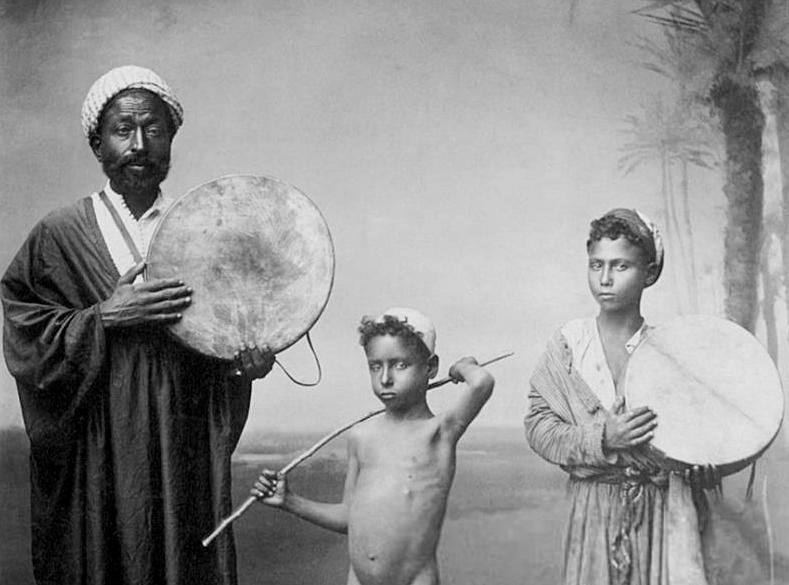
Egyptian Boys Activities: The Arts

Figure 1.-This is the close-up of a photo taken in North Africa (probably in Cairo) during the late-19th century. It shows a group of singers and dancers (a man a boy and a girl). We are not sure where they may have perforned. As other photos taken in those times the people are posing. Photographing actual performances were beyond the capability of 19th century photographers, especiallin the Middle East. The boy is pictured unclothed. This was permissable according Shafi'i school (one of the four Sunni schools of Islamic law) that doesn't dictate any clothing rule for boys till they reach puberty. A HBC reader writes, "I have doubts about this photo. Although possible, the scene is unusual. We know that there were also photos where the people posed unclothed at photographer's request." This is because market for these photographs was primarily European. Some photographers like Marcel Eugène Chatelain took many posed photographs, focusing primarily but not enturely on the female nude.
|
|
As in other Muslim countries, the arts were no well developed in Egypt. The visul arts were almost notexistent because of Islamic prohibitions on the representation of the human form, sometimes extended to animals as well. Thus until the invention of photography we do not have images of Muslims in most country. Persia and India has aore relaxed view of the Koran. But in Egypt, the Levant, and rhe rest of North Africa we have no visual depictions. Some Western artists engaged in Orientalism during the 19th centurty, but often they were imaginary depictions, not based on travel in the region. Some had an erotic appeal to buttoned up European Victorians. The most developed art form was architecture which became most developed in the construction of beautiful mosques, but there was no involvemnt of boys here because extensive knowledge is required to design and build these magnificent structures. Music and dance were a little different. This is an issue not specufically addressed in the Koran and thus is a matter of discussion among Islamic scholars. We see instruction in Islamic literatue like, "The prohibition of intentionally listening and giving ear to haram (forbidden or proscribed by Islamic law) songs and music has beenmentioned in the holy tradition. The Messenger of Allah (s.a.w.) said, 'And the person with the [sin of] singing (al-ghina’) will be raised [on the day of resurrection] blind, deaf and dumb. The person with [the sin of] adultery, of wood-wind, and of drum will also be raised in the same way.'” [As-Sayyid] The general opinion is that some music and dance is acceptableas long as it is not senuous--on which which there is a matter of some debate. And some firm have appeared that are clearly sensuous in Muslim socities that were tolerant on such matters. The best example is belly dancing. In some cases children have been involved,both boys and girls. Islamic scholars have also differed on where music abd dance are pemissible. Performing in front of a husband is generally tolerated. Performing in front of other men and women more suspect anfd forbidden by some scholars.
CIH

HBC Chronolgy Pages in the Boys' Historical Web Site:
[The 1880s]
[The 1890s]
[The 1900s]
[The 1910s]
[The 1920s]
[The 1930s]
[The 1940s]
[The 1930s]
[The 1940s]
[The 1950s]
[The 1960s]
[The 1970s]
[The 1980s]
Navigate the Children in History Website
[Return to the Main Egyptian activities page]
[Return to the Main Egyptian page]
[Return to the Main Egyptian economy page]
[Introduction]
[Animals]
[Biographies]
[Chronology]
[Climatology]
[Clothing]
[Disease and Health]
[Economics]
[Ethnicity]
[Geography]
[History]
[Human Nature]
[Law]
[Nationalism]
[Presidents]
[Religion]
[Royalty]
[Science]
[Social Class]
[Bibliographies]
[Contributions]
[FAQs]
[Glossaries]
[Images]
[Links]
[Registration]
[Tools]
[Children in History Home]
Created: 4:04 PM 8/22/2017
Last updated: 4:04 PM 8/22/2017



